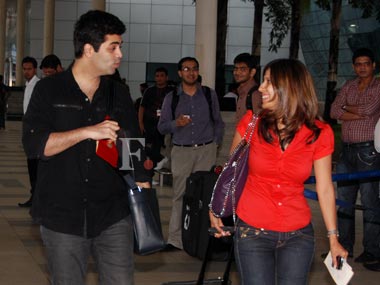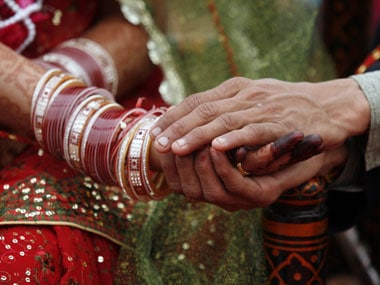June is the traditional month for weddings, and this year, for big, fat corporate weddings. The kind of overpriced extravaganzas staged by very rich people that leave the rest of us gawking in their wake. The two mega-mergers this month, however, offered an intriguing study in contrasts.
On 5 June, NR Narayana Murthy’s son got hitched in a private ceremony followed by a piffling 2,000-strong reception which featured a bunch of big corporate honchos and politicians. A puny showing in comparison to billionaire GVK Reddy’s 100-crore circus that hijacked all of Hyderabad - and most of Bollywood - this past weekend.
The Reddy nuptials offered everything we have come to love and expect of the super-rich icons of ’new India.’ Wild orgy of spending? A-plus celebrity guest list? Journalists drooling adjectives all over the news? Check, check, and check! In comparison, the NRN wedding was almost socialist in its austerity, harking back to an older time when the very wealthy preferred discretion over ostentatious display.
[caption id=“attachment_24833” align=“alignleft” width=“380” caption=" GVK Reddy’s 100-crore circus hijacked all of Hyderabad - and most of Bollywood. Photo by Raju Shelar/Firstpost"]
 [/caption]
[/caption]
And yet a closer look at the stars of the two events offers a different view. NRN’s son, Rohan, a PhD student at Harvard, tied the knot with TVS heir apparent, Lakshmi, a Yale graduate with a doctorate in engineering management. Both are 27-years old and in the same social league, but appear to have picked one another without any prodding from their parents. Except for the gigantic net worth involved, it could be a match made in any modern middle class home.
The young twenty-year-old Mallika Reddy, on the other hand, married the Indu Group scion Sidharth, a boy hand-picked by her parents for possessing all the right credentials. For all the upper crust glitz and state-of-the-art glamour, this is an old-fashioned business alliance that harks back to khandaani rishtas of yore. The latest Reddy marriage is a jolting reminder of how many of our wealthiest business families remain tightly wedded to the past, thumbing their nose at over two decades of social change.
Impact Shorts
More ShortsPartying like it’s 1985
Much of the hype about rising, shining India is shaped by media images of our business leaders. These international jetsetters with fabulous, cosmopolitan lifestyles are held up as exemplars of the Global Indian: modern, ambitious and wildly successful. GVK Reddy, ranked #47 on Forbes India’s Richest list , is certainly one of them.
Firstpost gives you a peek into the celebrity guest list for the Reddy wedding:
.daylife_smartgalleries_container p {
width: 100%;
height: 100%;
margin: 0;
padding: 0;
border: 0;
background: transparent;
}
And yet this weekend, despite all that champagne and caviar, the Reddys were partying like it’s 1985. The year I graduated from my chi-chi public school and also the year a number of my wealthy Marwari classmates were expeditiously married off - much like Pinky Reddy who entered the GVK household at the tender age of eighteen. In a society magazine profile , the daughter of one of India’s wealthiest politicians describe her early married life:
These little [cook]books are what saved me when, as an almost 18 year old, I went along with my brand new, week-old husband to the US where he was studying for his MBA at the University of Michigan, Ann Arbor. While he studied, I cooked. For him and his friends and I became so popular with everyone, because of all the exotic Indian cooking.
Not much has changed with the Reddys in the intervening years, except her daughter got a couple extra years - including a short stint in London - to enjoy the undomesticated life. It’s what passes for a generation gap in conservative business families across India.
I am struck by how little has changed for women in these families at a recent visit to a successful fashion designer’s warehouse. He is busy tending to a pair of wealthy Gujarati clients putting together a wedding trousseau; ’everyday’ clothes that the bride-to-be will need for her new life with the in-laws. They bark orders as the women pull trendy runway dresses off the hangers, each to be rejiggered into a demure salwar- or churidar-kameez. Necklines are too deep, the mother grumbles, and hemlines too high. A little skin showing in the back? Perish the thought.
“You have to make a dupatta for each of these,” says the sister, “She has to cover her head where she’s going.” They run up a tab of eight lakh in less than an hour.
But where is she going, I ask later. A village, or a small town perhaps?
“Hyderabad, you fool!” exclaims my friend, laughing out aloud at my undisguised surprise. “That’s the way it is with these families. It’s amazing, huh? The rest of the world is changing, but these guys have held on to their tradition like that,” he says, clenching his fist tight.
It is indeed amazing when placed in the context of the sweeping social change that has transformed urban families - be it lower, middle or upper middle class - over the past two decades. We’ve all accepted - eagerly or otherwise - the idea that our daughters will lead very different lives from generations past.
Story continues on next page
Our daughters, our selves
“The other day I was watching Satyajit Ray’s Mahanagar about this middle class woman who takes up a job. And all the tension and drama it creates within the family,” describes a friend, “And it felt so dated. It’s hard to imagine making that movie today.” Neither of us can name a single twenty-something - either family or friend - who isn’t working or studying for an advanced degree . The Twelfth standard- or B.A-pass girl raised solely to be a housewife is quietly growing extinct in the educated middle class.
Even the better-paid household help in the cities often educate their daughters with the same aspirations as their employers. “Let her study,” says my mother’s caregiver of her twenty-three-year-old daughter doing a graduate degree in sociology, “She will marry when she is ready.” My maid may be less ambitious, but she too has made sure that her daughter attends an English-medium school.Poor and lower middle class families in small towns and villages now send their daughters to distant cities to seek their fortunes, be it as an attendant, call centre worker, or service employee. We all get it: the world has changed; we and our daughters must change with it.
Of course, there are far too many exceptions for this to be a rule. And some parts of the country are more conservative than others. But it’s safe to say that the tide of liberalisation which raised the fortunes of innumerable families (while sinking others) has also raised the status of women. Upward mobility for the parents has translated into greater freedom and options for their daughters.
[caption id=“attachment_24821” align=“alignleft” width=“380” caption=" For Mallika Reddy’s wedding there’s barely any mention of the young bride. She lies buried in reams of breathless prose, described in passing as merely GVK Reddy’s granddaughter. Reuters"]
 [/caption]
[/caption]
But not so for girls in traditional business communities which have grown their wealth without changing their worldview. They have chosen instead to remain out of step with the changing times, with one hand firmly holding back the clock while the other swings the latest designer bag.
Who’s that girl?
“Oh we have houses around the world: Seattle, Hong Kong, Nairobi, Dubai…,” says the young twenty-something woman. Dressed in a pretty top and expensive pants, she exudes effortless urban chic. An image that dissipates as she launches in to the details of her life: marriage at 18, followed by a child soon after, she’s spent her life following her husband around the world.
“Actually my name isn’t [X],” she confesses cheerily, “My in-laws changed it when I got married.” I nearly spit out my drink.
“You did what?!” I squeak in disbelief. What I really mean is: which globe-trotting, sophisticated, wealthy young woman would even agree to such antiquated crap?
When I grumble to my mother, she merely shrugs, “They have all this money, live in luxury. What does it matter if they study or work?” But is money the only reason why we nurse greater ambitions for our daughters? Merely to secure their material comfort?
Just maybe we also believe that educating our kids, nurturing their freedom and offering them choices helps them grow and thrive. We accept generational change because to do otherwise is to deny our daughters what they need most: a secure and independent sense of self.
“Have I lost my identity as a woman, in Murty’s shadow? No. I might be Mrs. Narayan Murty. I might be Akshata and Rohan’s mother. I might be the trustee of Infosys Foundation. But I am still Sudha,” writes NRN’s wife Sudha Murty in her autobiography, “I play different roles like all women. That doesn’t mean we don’t have our own identity…. And we have to exact our freedom by making the right choices in our lives, dictated by us and not by the world.”
Her worldview has certainly shaped the trajectory of her daughter’s life. When NRN’s daughter married her business school sweetheart back in 2009, news stories carefully detailed her extensive resume: A 29-year old Claremont McKenna graduate with an MBA from Stanford; employed as a marketing director in San Francisco-based green technologies firm; one of Infosys’ largest individual shareholders with 1.4 per cent stake and a net worth of about Rs 1,600 crore.
Mallika Reddy’s wedding, in comparison, has been the subject of a far bigger media blitz. Yet in the countless news stories detailing the celebrity guest-list and wedding arrangements, there’s barely any mention of the young bride. She lies buried in reams of breathless prose, described in passing as merely “GVK Reddy’s granddaughter.”
In 2011, that’s a little sad.
)